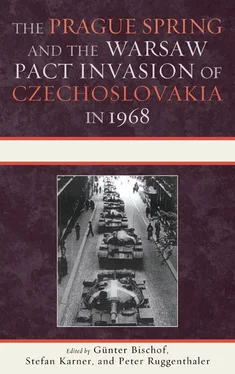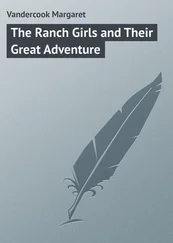Johnson’s desire for a summit was motivated by more than a simple improving of his image at home and abroad, as Jeremi Suri has suggested. A summit in 1968 might have frozen the arms race in intercontinental missiles and resulted in nuclear parity. Instead, the arms race continued, and the ICBMs were upgraded with MIRV technology, notes John Prados. 71One of the consequences of the continued arms race was the rise of the neocons and their critiques of Soviet superiority in the arms race and the entire détente agenda. This brought Ronald Reagan to the White House and the resumption of the Cold War. The setbacks of 1968 may have been the year when the United States entered a declining trajectory in its position of global hegemony. 72Indeed, as the West Europeans frequently noted in the course of the Czech crisis, during the dual crisis of Vietnam and the Warsaw Pact intervention in Czechoslovakia, American leadership was lackluster.
For help in preparing this chapter, I am grateful to the archivists and librarians at the Lyndon B. Johnson Library and the National Archives and Records Center in College Park, Maryland. Scott Manguno has assisted me with research, and Peter Ruggenthaler has been a valuable reader and sympathetic critic. From Mark Kramer and Thomas Schwartz’s work I have learned enormously over the years. Vladislav Zubok has also helped clearing up some points.
1. See the unpublished paper by Günter Bischof, “Respecting Cold War Boundaries: U.S. Responses to the Soviet Invasions of East Germany (1953), Hungary (1956), Czechoslovakia (1968),” lecture delivered in the conference in honor of Charles S. Maier, Crossing Boundaries: International History in a Global Age , American Academy, Berlin, Germany, 7 June 2008.
2. On the crisis year 1968, see Mark Kurlanski, 1968: The Year That Rocked the World (New York: Ballantine, 2004); Ronald Fraser, ed., 1968: A Student Generation in Revolt (New York: Pantheon, 1988); for the larger context of the 1960s, see Terry H. Anderson, The Movement and the Sixties: Protest in America from Greensboro to Wounded Knee (New York: Oxford University Press, 1995); David Bruner, Making Peace with the 60s (Princeton, NJ: Princeton University Press, 1996); Arthur Marwick, The Sixties: Cultural Revolution in Britain, France, Italy, and the United States, c. 1958–c. 1974 (Oxford: Oxford University Press, 1998).
3. On the Johnson presidency, see Robert Dallek, Lyndon B. Johnson, Portrait of a President (Oxford: Oxford University Press, 2004); Randall Woods, LBJ: Architect of American Ambition (New York: The Free Press, 2006); Bruce J. Schulman, Lyndon B. Johnson and American Liberalism: A Brief Biography with Documents , 2nd ed. (Boston: Bedford/St. Martin’s, 2007); John L. Bullion, Lyndon B. Johnson and the Transformation of American Politics (New York: Pearson Longman, 2008).
4. The secondary literature on these events is considerable. Among the most important publications are Thomas Alan Schwartz, Lyndon Johnson and Europe: In the Shadow of Vietnam (Cambridge, MA: Harvard University Press, 2003); Jeremi Suri, Power and Protest: Global Revolution and the Rise of Détente (Cambridge, MA: Harvard University Press, 2003); Vladislav M. Zubok, A Failed Empire: The Soviet Union in the Cold War from Stalin to Gorbachev (Chapel Hill: University of North Carolina Press, 2007); Mark Kramer, “The Czechoslovak Crisis and the Brezhnev Doctrine,” in 1968: The World Transformed , ed. Carole Fink et al., Publications of the German Historical Institute, Washington, DC (Cambridge: Cambridge University Press, 1998), 10–71; H. W. Brands, ed., The Foreign Policies of Lyndon Johnson beyond Vietnam (College Station: Texas A&M University Press, 1999); H. W. Brands, The Wages of Globalism: Lyndon Johnson and the Limits of American Power (New York: Oxford University Press, 1995); Robert A. Divine, “Lyndon Johnson and Strategic Arms Limitations,” in The Johnson Years , vol. 3, LBJ at Home and Abroad , ed. Robert Divine (Lawrence: University of Kansas Press, 1994), 239–79; Mitchell B. Lerner, ed., Looking Back at LBJ: White House Politics in a New Light (Lawrence: University of Kansas Press, 2005); Warren I. Cohen and Nancy Bernkopf Tucker, eds., Lyndon Johnson Confronts the World: American Foreign Policy 1963–1968 (Cambridge: Cambridge University Press, 1994); Lawrence Kaplan et al., eds., NATO after Forty Years (Wilmington, DE: Scholarly Resources, 1990); Vojtech Mastny, “Was 1968 a Strategic Watershed of the Cold War,” Diplomatic History 29, no. 1 (2005): 149–77; Mitchell Lerner, “Trying to Find the Guy Who Invited Them: Lyndon B. Johnson, Bridge Building and the End of the Prague Spring,” Diplomatic History 21, no. 3 (2008): 77–103; Hal Brands, “Progress Unseen: U.S. Arms Control Policy and the Origins of Détente, 1963–1968,” Diplomatic History 30, no. 2 (2006): 253–85; John C. McGinn, “The Politics of Collective Inaction: NATO’s Response to the Prague Spring,” Journal of Cold War Studies 1, no. 3 (1999): 111–38; A. Paul Kubricht, “Confronting Liberalization and Military Invasion: America and the Johnson Administration Respond to the 1968 Prague Summer,” Jahrbücher fur Geschichte Osteuropas 40, no. 2 (1992): 197–212; Andreas Daum et al., eds., America, the Vietnam War, and the World: Comparative and International Perspectives , Publications of the German Historical Institute, Washington, DC (Cambridge: Cambridge University Press, 2003); Alexandra Friedrich, “Awakenings: The Impact of the Vietnam War on West German–American Relations in the 1960s” (Ph.D. diss., Temple University, 2000).
5. The sources for this chapter come from three major documentary collections: the National Security Council files and other file collections in the Lyndon Baines Johnson Presidential Library in Austin, Texas (LBJL), as well as two collections in the National Archives and Records Administration in College Park, Maryland (NARA); first, the documents in the file collection “POL 27-1 COM BLOC-Czech” (hereafter abbreviated as POL-27) and “POL Czech—USSR DEF 4 NATO” (hereafter abbreviated as POL Czech), “Central Foreign Policy Files 1967–1969 [CFPF]” in Record Group 59, the General Records in the Department of State; secondly, the “Czech Crisis Files” (Lot 70 D 19) (hereafter abbreviated as CCF) in the Office of the Executive Secretariat of the Department of State, also in RG 59. I have contributed U.S. documents to the collection of Karner et al., Dokumente . U.S. documents reprinted in the basic collection of the Department of State, Foreign Relations of the United States , vol. 17, Eastern Europe 1964–1968 (Washington, DC, 1996), are hereinafter abbreviated as FRUS, unless another volume from this series is specifically referenced. Johnson’s official public statements and speeches are conveniently reprinted in Lyndon B. Johnson, The Public Papers of the President of the United States , 1968–1969 , 2 vols. (Washington, DC: Office of the Federal Register, National Archives and Records Service, General Services Administration, 1970) (hereafter abbreviated as PPP). Frequent references will be made to the massive volume of essays by Karner et al., Beiträge .
6. “Soviet threat to Czechoslovakia,” Rostow to Rusk, 10 May 1968, Folder “6/1/68,” Box 1558, POL-Czech, RG 59, NARA (reprinted in appendix 3 of this volume).
7. “Saber-Rattling,” in CIA memorandum “The Czechoslovak Situation,” 9 May 1968, Folder 6, and “Present USSR Attitude toward Czechoslovakia,” Folder 3, both Box 179, NSC Country Files Czechoslovakia, LBJL; see also the chapter by Donald P. Steury in this volume.
Читать дальше












